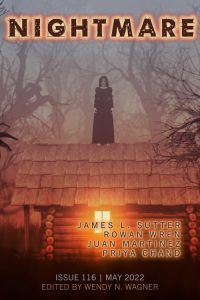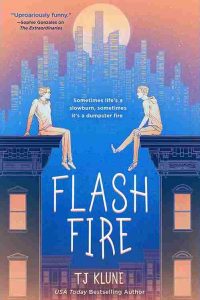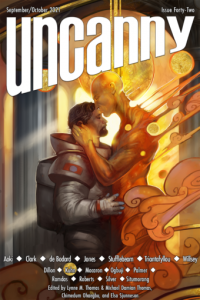Paula Guran Reviews Short Fiction: The Dark and Nightmare
 The Dark 3/22, 4/22
The Dark 3/22, 4/22
Nightmare 3/22, 4/22, 5/22
There’s quite a variety in the four originals of The Dark #83. In “Knotlings” by Aliya Whiteley, the narrator accepts her pain as a good thing. She rejoices when her son experiences the same affliction and, like her, vomits up “knotlings.” The mother teaches her son how to cope, but as he matures, he develops his own way of handling it. Ultimately, this is a very weird variation of the eternal story how offspring grow up and become themselves. Sheila’s house is just getting to some semblance of what she always wanted it to be in Steve Rasnic Tem’s “Black Wings.” Clearing the house of a myriad of bird specimens collected by her recently deceased husband, has been no small job. A strange bird appears and bedevils Sheila. Things just aren’t going to be the way she wants. It has a good twist end. The interesting “Xiǎo Èmó–Little Demon” by Ai Jiang is about Měi, whose parents sold both her older sisters like animals but died before they could sell her as well. Now, the spirits of sisters Ér and Míng are resentful that Měi has survived. They use Měi and her beauty to avenge their deaths. The fourth story did not set as well with me as the other three: After seeing the decomposing corpse of a dead pig, Martin starts to experience a strange skin infection in “Farrow” by Jack Klausner. Nothing helps and it worsens.
The four stories of The Dark #82 are all family themed. The titular character of “Douen” by Suzan Palumbo is the spirit of a dead child. Samantha, the douen of this story based in the folklore of Trinidad and Tobago, returns to her family to discover no one but her dog can see her and a cousin appears to be taking her place in their affections. It’s a nuanced and well-told tale. The reader will grasp what is going on in the well-crafted “With All Her Teeth” by Kali Wallace, the story of a violently dysfunctional family. When the central character, twelve-year-old Henrietta, confirms what we know, Wallace ends the story. The stasis is unsettling, but also somewhat unsatisfying. The family in the unrelentingly brutal “Mother” by Rebecca Hirsch Garcia is beyond dysfunctional. Father and offspring abduct and “train” women to be the “mother.” They’ve gone through a lot of “mothers.” Daughter Delilah gets to choose the next victim, and the story evolves into one of their relationship. In “Shrine,” Kirstyn McDermott explores grief and the possibility that the dead need the living to let go of them as much as the living need to let go. It’s more thought than story.
“The Golden Hour” by Erica Ruppert is one of two full-length originals in Nightmare #114. A mysterious light finds Benjamin in the stream; his brother, Thomas, wanting the light for himself, attacks Benjamin. Benjamin dies and although Thomas gets a taste of it, the light eludes. It gets too complicated to convey more here, but Thomas winds up as something creepy that preys on other children and drinks their blood. Ruppert packs a lot into about 3400 words, but the story would have been more effective if we had known more about Benjamin and Thomas. By extension, we would have then known more about the light and its nature. Kudos to Ruppert for making me want more, but boo for making me ask.
Baby Liam, in R.L. Meza’s story “The First Year”, is an internet sensation whose rabid followers are obsessed with his every electronic coo. Mother Olivia, however, seems to be fading to nothingness. As horrific as the fictional events become, one can’t help but think they would be all the more so if Olivia were a happy mother. The fact she’s suffering from postpartum depression – or maybe worse – allows the reader to wonder if things are at least partially imagined.
Shaoni C. White’s “Where the Heather Grows”, one of two new full-length stories in Nightmare #115, tells of Clara, who never had a sister, never lived where the heather grows, never fell in love (let alone with the same man as a sister), and neither she nor her non-existent sibling ever drowned in a river. But Clara, evidently haunted by a folk song, hears a river rushing through her kitchen and is beset with thoughts of murder and drowning. I wish this one were a little more atmospheric.
In “Synchronus Online” by Shannon Scott, an instructor gives her Zoom college classroom in “an assignment… widely open to interpretation, with no guidelines or limitations.” Grades are peer generated. It results in everything from confessionals to a snake eating a rat to fake snuff porn. This leads to a predictable ending. The teacher is not a sympathetic character, and it is difficult to connect with the story.
James L. Sutter allows us to really get to know the children in “And All Their Silent Roars,” and, as a result, he produces a successful story for Nightmare #116. Although the diagnostic phrase does not fit the 1980s setting, eight-year-old Denny – who is obsessed with toy animals – is probably on the spectrum. Ten-year-old Jeremy fulfills the older brother role well, and self-obsessed adolescent Charlotte thinks her life is ruined by the family’s relocation. The children adapt to their new life. Denny and Jeremy find a bag of toy animals, which turn out to be rather disturbing. Good brother Jeremy tries to get rid of them, but they reappear. The family is never the same.
Also in Nightmare #116: Dani is a dead girl whose body is dumped in a river. Rowan Wren’s “In the Water” is told from her perspective as her body drifts downstream. It’s interesting in a forensic way but lacking gruesomely accurate details, which, depending on the reader’s taste, may or may not be a positive.
Recommended Stories:
“Douen”, Suzan Palumbo (The Dark 3/22)
“And All Their Silent Roars,” James L. Sutter (Nightmare 5/22)
Paula Guran has edited more than 40 science fiction, fantasy, and horror anthologies and more than 50 novels and collections featuring the same. She’s reviewed and written articles for dozens of publications. She lives in Akron OH, near enough to her grandchildren to frequently be indulgent.
This review and more like it in the June 2022 issue of Locus.
 While you are here, please take a moment to support Locus with a one-time or recurring donation. We rely on reader donations to keep the magazine and site going, and would like to keep the site paywall free, but WE NEED YOUR FINANCIAL SUPPORT to continue quality coverage of the science fiction and fantasy field.
While you are here, please take a moment to support Locus with a one-time or recurring donation. We rely on reader donations to keep the magazine and site going, and would like to keep the site paywall free, but WE NEED YOUR FINANCIAL SUPPORT to continue quality coverage of the science fiction and fantasy field.
©Locus Magazine. Copyrighted material may not be republished without permission of LSFF.






